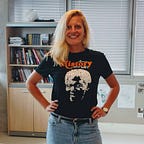“It is hard to be unbiased” — an Oral History Project.
The aim of Oral History is to preserve accounts that are not highlighted in the mainstream discourse due to a range of reasons. The voices heard through Oral History are stories not acknowledged or presented in dominant narratives, because these are perceived insignificant or never captured. The aim of this Oral History project was exactly that: recording stories of people that are often forgotten or dismissed. The eventual result was for as well teacher as students inspiring.
This Oral History project took place at an international baccalaureate school, hence the assignment was tweaked to make it suitable for the Middle Years Program. This project took place in MYP4, which is comparable to grade 9. The core of the project was to interview someone whose experiences in the past are rather unknown among the general public. One can adjust the design of the assignment in a way to make it fit into the existing curriculum.
The project required quite some work from the students, therefore they received a document, which sets out the entire assignment including the assessment criteria, from the start. This assignment was done in pairs, based on existing friendships in the classroom.
There are not many informative and entertaining videos online that explain the purpose and features of Oral History, the best of the rest was a video created by The Oral History Centre. This video gave the students an idea of what Oral History contains and what they were expected to do.
In the following lessons, students would focus on the past of their interviewee. The whole project was based on a research question formulated by the students. The first step, therefore, was the writing of a mini-research regarding a particular event in the life of the interviewee about which the students wanted to know more. Thereafter, the students used information from their mini-research to formulate interview questions. An example exercise for this was the following: the students looked at a photo and thought of questions they could ask the people in the photo now, about this particular event.
Another exercise that surprisingly produced useful insights was a simulation of conducting an interview. The students worked in groups of four, whereby two students were observers and two students pretended to be the interviewee and interviewer. During this short practice interview, the students gathered some insightful information regarding the art of interviewing. For instance that interviewing and writing simultaneously is impossible, or that it is important to make sure your interviewee elaborates on his/her answers. Furthermore, a video created by students of the USC college was helpful for the students to think of relevant and good interview questions.
The students had to record the interview because the information from the interview would be the base of their research. The students did not have to transcribe the entire interview as that would have been too much work, but the transcription was limited to interesting quotes. The students produced an answer to their research question by combining the information from their mini-research with the information from the interview. At the end of the research, the students wrote a reflection about what they learned and how they approached this Oral History Project. An example:
The primary thing we enjoyed and is important about oral history is the fact that it is raw information. It is a perspective straight from a person that witnessed an interesting part of American history. The great thing about oral history is the voice you hear as well. Through the emotion and tone in her voice you can hear her experience and what it meant for her.
The end result was inspiring because incredible interesting stories were discovered, causing most students to work hard. The final stage of this intense project was the creation of a symbolic portrait of their interviewee. This symbolic portrait could be given as a “thank you” present, but it also functioned as a differentiation tool to make sure that students who might not be the best writers could express the story of their interviewee in another way.
This project was enjoyable as it stimulated students to speak to either their great-parents or other elderly, which created interesting conversations among them. Furthermore, the students did not only learn more about their own family or community history but also about each other’s heritage. By conversing with each other, students realized certain prejudices they might have about other cultures and ways of living. Besides that the art of interviewing, thinking of interview questions, conducting a research, comparing secondary and primary sources are skills that can be used in any context and are not limited to social science or oral history. All these elements made this project extremely successful and definitely the highlight of this year so far.
Some of the ideas for this unit were derived from an article written by Michelle Johansen and Martin Spafford in Teaching History.
Johansen, Michelle, and Martin Spafford. “‘How Our Area Used to Be Back Then’: An Oral History Project in an East London School.” Teaching History, no. 134 (2009): 37–46. http://www.jstor.org/stable/43260202.
Another useful resource was the book “The Oral HistoryWorkshop: Collect and Celebrate the Life Stories of Your Friends and Family”.
During my undergraduate studies at Leiden University, I followed a subject on Oral History that resulted in an oral history research on my great-aunt about migrating from the Dutch Indies to the Netherlands in the 1950’s.
Originally published at mizsdafreeze1.wordpress.com on May 2, 2018.
